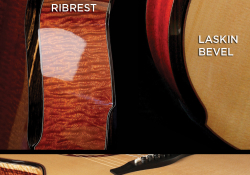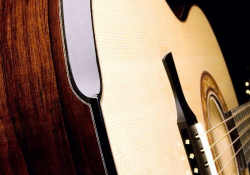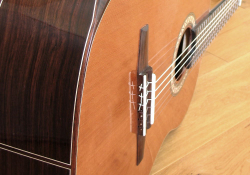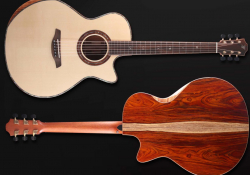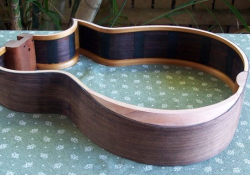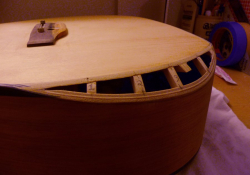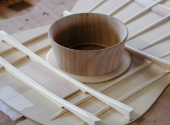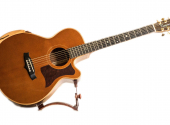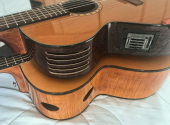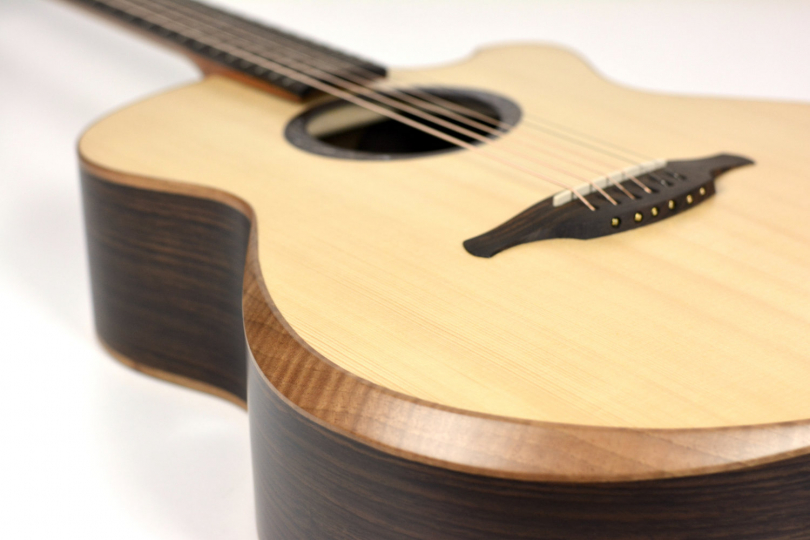
Laboratorium of Dr. Hyenik #7: Bevel Edge
Another upgrade, which until recently was a luxury speciality reserved for boutique guitar makers, is now entering mass production. For example, Walden offers some pieces that also include this feature. So let's have a look at the acoustic bevel edge together.
The bevel edge of the acoustic guitar body could make the impression of a VIP visual detail or perhaps even a marketing ploy to suck extra money out of customers, but the sales pitch is clear. Not only does it provide the guitarist with unexpected comfort, but it also protects the muscles, tendons and nerve endings in their forearms. That's why another terminus technicus is used – armrest. Moreover, this invention has been created exactly as new products should ideally be created – as a response to market demand.
The now legendary Canadian luthier William "Grit" Laskin was approached in the 1980s by a classical guitar player who wanted to make the edge of his guitar body round because the sharp edge was causing him discomfort and almost health problems. So he came up with a technical solution, which became known as Laskin Arm Rest. It was not only the customer who was satisfied – he even started receiving letters of thanks from doctors and physiotherapists for coming up with this invention finally. Following the usual and meritorious practice of top guitar makers, he did not keep the idea only for himself but presented it both at specialized symposiums and in the trade press and with his permission and mention of authorship, other luthiers could also apply this detail.
Another milestone was the so-called Ryan Bevel by guitar maker Kevin Ryan, who technologically refined the idea into a "visually elegant solution" that has been adopted by many other guitar makers. For electric guitars, ergonomic body bevelling has become more or less standard due to its manufacturing triviality, but greater adoption in acoustic guitars has been hampered by the considerable technological complexity of the procedure, as the following video tutorial clearly demonstrates.
However, with the gradual development of the market, the need to differentiate from the competition, and especially the ever-increasing demands of customers (do we even realize what fantastic times we live in today?), the incriminated bevel has been brought to notice more and more, until Taylor, as probably the first daring manufacturer, took it up.
After all, it was at the Taylor roadshow that I was able to physically test this improvement for the first time, to feel and experience what I had not been particularly excited about before based on pictures alone. But I had no idea that such a little something would be so pleasant and comfortable! And so I have included this detail in my decision-making process when choosing potential new instruments in the future. If you haven't tried it, you won't believe it, just like me.
Fortunately, more and more companies (even from the cheaper segments) have worked up the courage, so you can try Washburn from the Woodline series, Cort Earth or Gold Edge, Taylors from the Academy and even an Ortega ukulele or acoustic bass. Of course, I've noticed this "feature" also in Czech guitar makers, e.g. Rozawood, Jech and ReBell guitars, so there are plenty of opportunities nowadays.
In addition, Grit Laskin continued to develop the idea of bevelled edges to the form of Rib Rest, an ergonomically adapted rear edge of the body so that the sharp edge does not press the ribs. I haven't tried this yet, but the brand-new Duo Bevel from Furch will soon allow me to do so.
Classical guitarists solved this problem much earlier and much more intensively (which is probably related to the higher intensity of their practice) – they commonly use external armrests in many variants and materials. Technically it is of course much easier than the integrated solution described above, just copy the body radius well and glue or clip this gadget on. The manufacturers argue mainly by the fact that this armrest does not limit the vibrations and loudness of the instrument, because the laid forearm does not mute the soundboard.
Although the muting phenomenon can be surprisingly significant, as Laurence Juber demonstrates with his wittily revolutionary Virtual Whammy lever technique, the hand is usually in a position where it mutes the vibrations of the soundboard very little. That is, unless you have an ultra-deep superjumbo and super huge forearm or, on the contrary, a hypersensitive dynamically responsive Spanish guitar. It is also absolutely clear in banjo, where the sharp metal edges of the body and the taut membrane absolutely require such a protector. There are many guitar products made of wood, leather, plastic, try looking for an armrest, armpad or make one yourself. If you know how to work with wood a bit and have basic tools, it won't be difficult for you.
However, I would recommend sticking with the wider dimensions, even though they don't look as visually cool as the thinner ones that will pinch your hand uncomfortably rather than make playing more enjoyable (I had to throw away one of these with a sexy look, unfortunately). So we have covered the bevels from the integrated ones to external artificial replacements – or from aesthetics to prosthetics – and we'll talk about the weird guitar implants again next time.
If you have found an error or typo in the article, please let us know by e-mail info@insounder.org.

